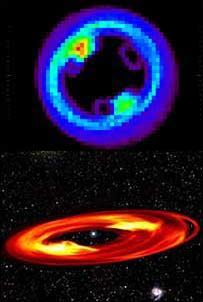Avi Blizovsky

Above: The bulge orbits Vega once every 300 years; Below a Neptune-like planet formed at the edge of the system
Direct link to this page: https://www.hayadan.org.il/clump1.html
Astronomers claim to have found evidence of the existence of a planet the size of Earth and made of rocks different from over a hundred planets discovered so far, all of which are gas giants of the type of Jupiter.
It is a disk of dust that surrounds the star, Vega, once every 300 years. Vega is one of the brightest stars in the sky, and is only 25 light years away from us.
It is 3 times larger than the Sun and its age, 350 million years, is much younger than the Sun. Luga has a disk of dust surrounding it, and at least one large planet may be sweeping up the rocky debris along with several smaller Earth-sized planets.
An analysis by astronomers from the Royal Observatory in Edinburgh was published in the Astrophysical Journal. It is based on observations taken by one of the most sensitive cameras in the world. The instrument, the Submillimetre Common-User Bolometer Array (Scuba) is connected to the James Clark Maxwell Harido Telescope in Hawaii.
In detailed images of Vega and its surroundings, the disk is clearly visible. It is made of very cold dust (180 degrees below zero) and surrounds the star.
New computer modeling techniques have shown that the structure seen in the disk can best be explained by a Neptune-like planet orbiting the star at a similar distance to Neptune from our Sun, and also having a similar mass.
The wide orbit of a Neptune-like planet means there is plenty of room for rocky Earth-like planets. "The shape of the disk is the key to why it probably contains planets." said Mark Wyatt of the Royal Observatory in Edinburgh. "Although we cannot directly observe these planets, they formed in bulges within the dust disk surrounding the star. If this is indeed the case, it may mean that Loga has a system of planets similar to ours." added
The Vega system may have evolved in a similar way to that of our solar system with gas giants like Neptune forming close to the sun, then beginning to be pushed out into their current orbits due to the mutual attractions between them and their neighbors. During this process, such giant planets suck up all the fragments that would otherwise have formed younger planets, allowing life to develop more easily on the terrestrial planets.
Wayne Holland, who made the original observations explains: "The model predicts that these lumps in the disk will rotate around the star once every 300 years. If we make more observations after a break of a few years, we can see the movement of these blocks. The model also predicts in a more detailed way the level of clumps in the disk, but in order to test this prediction, it is necessary to wait for the next generation of telescopes and cameras.
Vega will not escape, in a few thousand years it will be the North Star for us, when the Earth's axis of inclination towards the stars will change in a cycle that is 24 thousand years long.
For information on the BBC website
Know planets outside the solar system
https://www.hayadan.org.il/BuildaGate4/general2/data_card.php?Cat=~~~696158895~~~54&SiteName=hayadan
